stop start Oldsmobile Cutlass Supreme 1993 Owner's Manuals
[x] Cancel search | Manufacturer: OLDSMOBILE, Model Year: 1993, Model line: Cutlass Supreme, Model: Oldsmobile Cutlass Supreme 1993Pages: 340, PDF Size: 16.21 MB
Page 76 of 340
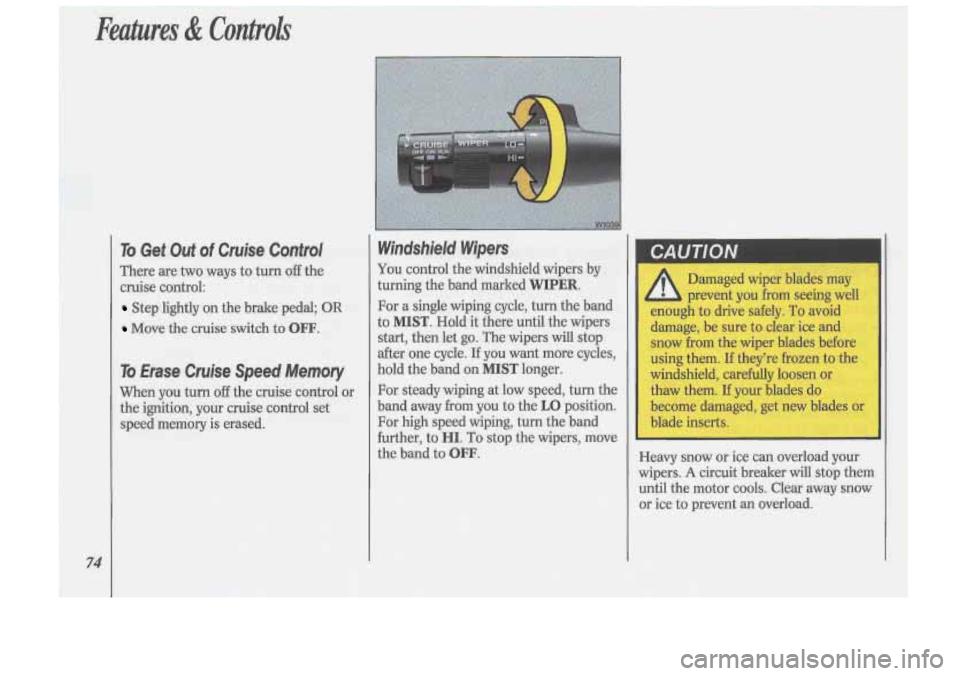
Features & Controh
74
To Get Out of Cruise Control
There are two ways to turn off the
cruise control:
Step lightly on the brake pedal; OR
Move the cruise switch to OFF.
To Erase Cruise Speed Memory
When you turn off the cruise control or
the ignition, your cruise control set
speed memory is erased.
Windshield Wipers
You control the windshield wipers by
turning the band marked
WIPER.
For a single wiping cycle, turn the band
to
MIST. Hold it there until the wipers
start, then let go. The wipers will stop
after one cycle.
If you want more cycles,
hold the band on
MIST longer.
For steady wiping at low speed, turn the
band away
from you to the LO position.
For high speed wiping, turn the band
further, to
HI. To stop the wipers, move
the band to
OFF. Heavy snow or ice can overload your
wipers.
A circuit breaker will stop them
until the motor cools. Clear away snow
or ice to prevent an overload.
Page 98 of 340
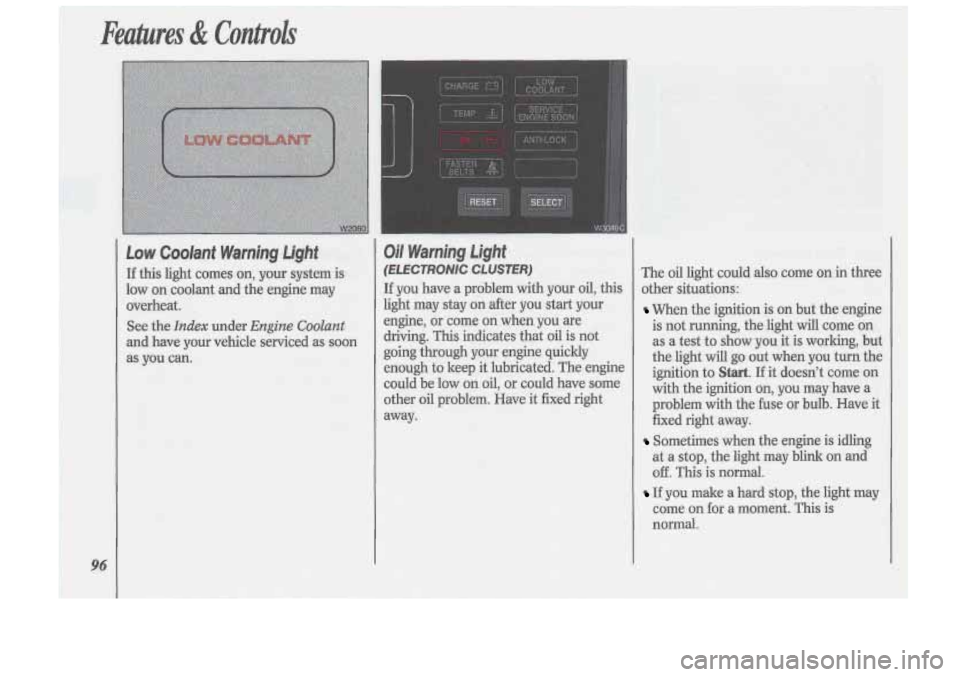
i-
Features & Controls
96
Low Coolant Warning Light
If this light comes on, your system is
low on coolant and the engine may
overheat.
See the
Index under Engine Coolant
and have your vehicle serviced as soon
as you can.
Oil Warning Light
(E LE CTRONlC CLUSTER)
If you have a problem with your oil, this
light may stay on after you start your
engine,
or come on when you are
driving. This indicates that oil is not
going through your engine quickly
enough to keep it lubricated. The engine
could be low
on oil, or could have some
other oil problem. Have it fixed right
away. The
oil light could also come
on in three
other situations:
When the ignition is on but the engine
is not running, the light will come on
as a test to show you it is working, but
the light will go out when you turn the
ignition to
Start. If it doesn’t come on
with the ignition on, you may have a
problem with the fuse or bulb. Have it
fixed right away.
Sometimes when the engine is idling
at a stop, the light may blink on and
off. This is normal.
If you make a hard stop, the light may
come on for a moment. This is
normal.
Page 101 of 340
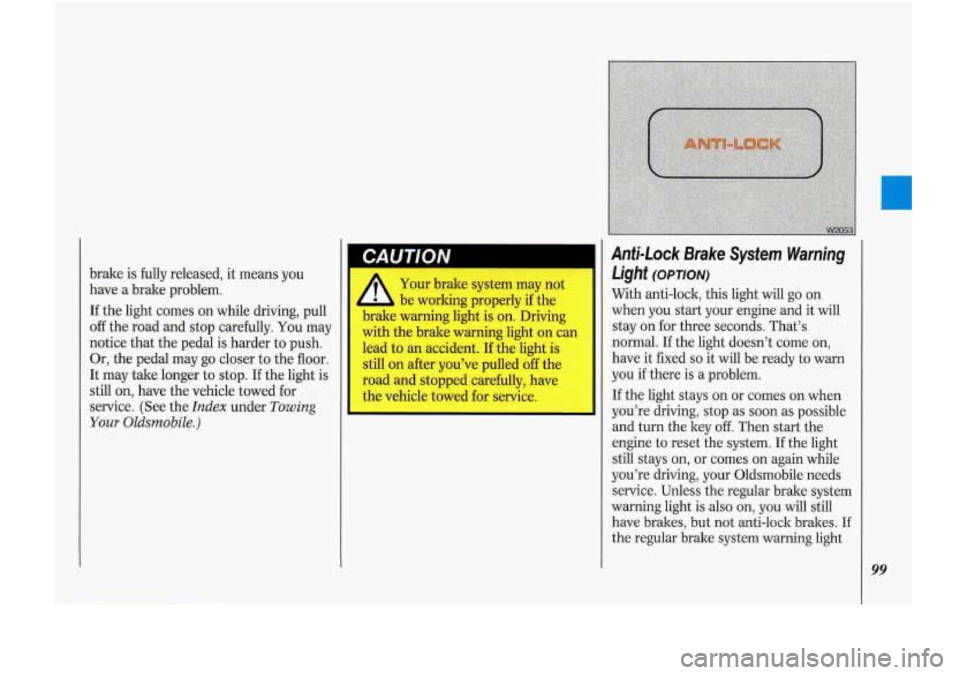
brake is fully released, it means you
have a brake problem.
If the light comes
on while driving, pull
off the road and stop carefully. You may
notice that the pedal is harder to push.
Or, the pedal may go closer to the floor.
It may take longer to stop. If the light is
still on, have the vehicle towed for
service. (See the
Index under Towing
Your Oldsrnobile.)
CAUTION
Your brake system may not I
be working properly if the
brake warning light is on. Driving
with the brake warning light on can
lead to an accident. If the light is
still on after you’ve pulled
off the
road and stopped carefully, have
the vehicle towed for service.
Anti-Lock Brake System Warning
Light
(opTloN)
With anti-lock, this light will go on
when you start your engine and it will
stay on for three seconds. That’s
normal. If the light doesn’t come on,
have it fixed
so it will be ready to warn
you if there is a problem.
If the light stays on or comes on when
you’re driving, stop as soon as possible
and turn the key
off. Then start the
engine to reset the system.
If the light
still stays on, or comes
on again while
you’re driving, your Oldsmobile needs
service. Unless the regular brake system
warning light
is also on, you will still
have brakes, but not anti-lock brakes.
If
the regular brake system warning light
99
Page 133 of 340
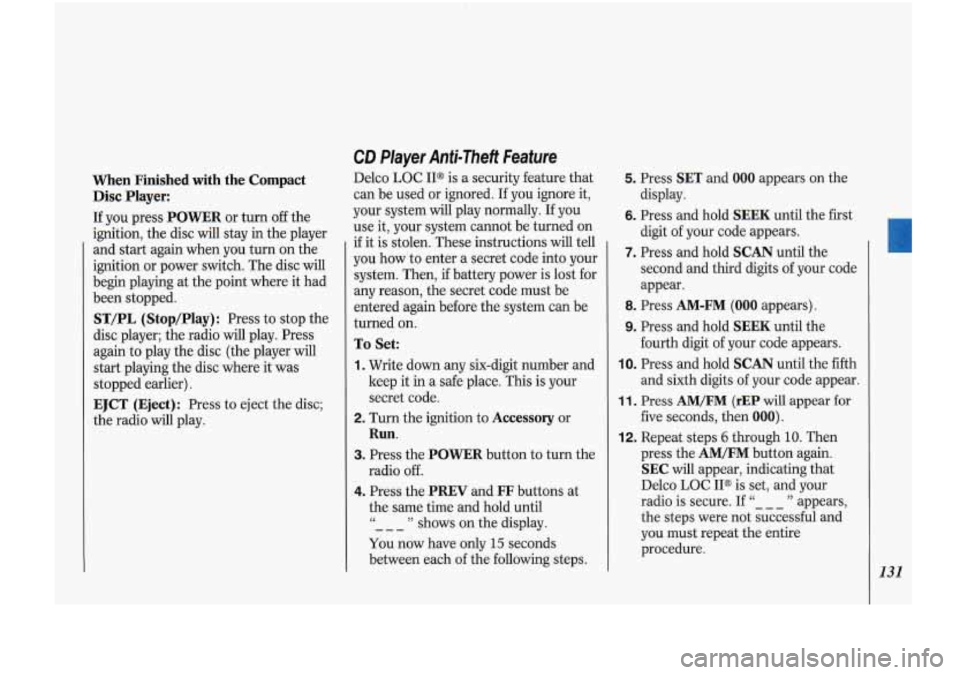
When Finished with the Compact
Disc Player:
If you press POWER or turn off the
ignition, the disc will stay in the player
and start again when you turn on the
ignition or power switch. The disc will
begin playing
at the point where it had
been stopped.
ST/PL (Stop/Play): Press to stop the
disc player; the radio will play. Press
again to play the disc (the player will
start playing the disc where it was
stopped earlier).
EJCT (Eject): Press to eject the disc;
the radio will play.
CD Player Anfi-Theft Feature
Delco LOC II@ is a security feature that
can be used or ignored. If you ignore it,
your system will play normally. If you
use it, your system cannot be turned
on
if it is stolen. These instructions will tell
you how to enter a secret code into your
system. Then,
if battery power is lost for
any reason, the secret code must be
entered again before the system can be
turned on.
To Set:
1. Write down any six-digit number and
keep it in a safe place. This is your
secret code.
Run.
radio off.
the same time and hold until
--- ” shows on the display.
You now have only
15 seconds
between each of the following steps.
2. Turn the ignition to Accessory or
3. Press the POWER button to turn the
4. Press the PREV and FF buttons at
;<
5. Press SET and 000 appears on the
6. Press and hold SEEK until the first
7. Press and hold SCAN until the
display.
digit of your code appears.
second and third digits of your code
appear.
8. Press AM-FM (000 appears).
9. Press and hold SEEK until the
fourth digit of your code appears.
IO. Press and hold SCAN until the fifth
and sixth digits of your code appear.
11. Press AM/FM (rEP will appear for
five seconds, then
000).
12. Repeat steps 6 through 10. Then
press the
AM/FM button again.
SEC will appear, indicating that
Delco
LOC II@ is set, and your
radio is secure. If
‘‘ ” appears,
the steps were not successful and
you must repeat the entire
procedure.
131
Page 153 of 340
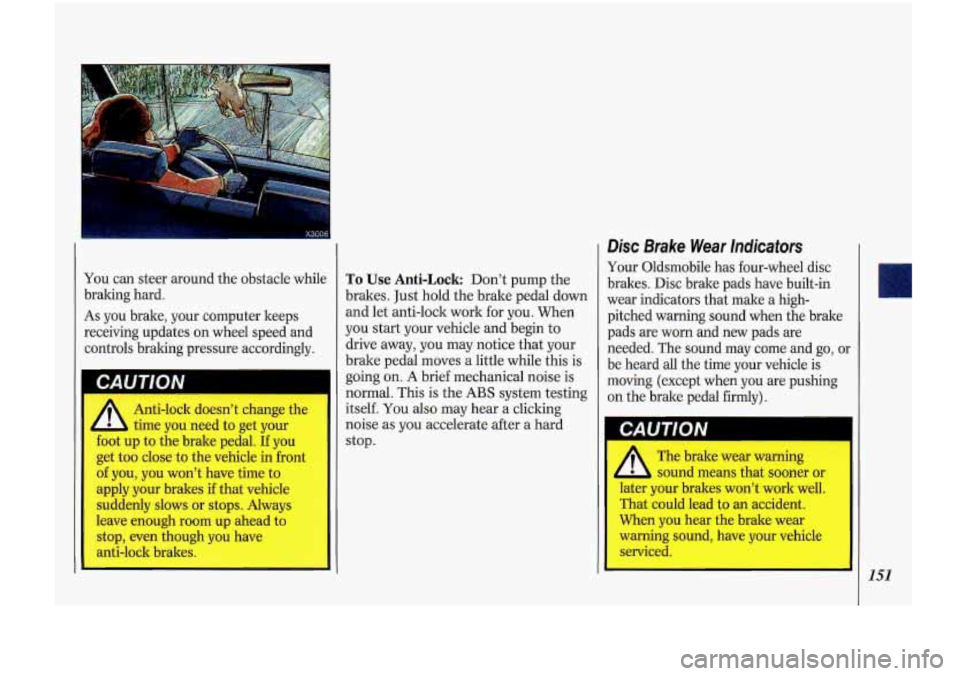
You can steer around the obstacle while
braking hard.
As you brake, your computer keeps
receiving updates on wheel speed and
controls braking pressure accordingly.
CAUTION
Anti-lock doesn’t change the
time you need to get your
foot up to the brake pedal.
If you
get too close to the vehicle in front
of you, you won’t have time to
apply your brakes if that vehicle
suddenly slows or stops. Always
leave enough room up ahead
to
stop, even though you have
anti-lock brakes.
To Use Anti-Lock: Don’t pump the
brakes. Just hold the brake pedal down
and let anti-lock work for you. When
you start your vehicle and begin to
drive away, you may notice that your
brake pedal moves a little while this is
going on. A brief mechanical noise is
normal. This is the
ABS system testing
itself.
You also may hear a clicking
noise as
you accelerate after a hard
stop.
Disc Brake Wear lndicafors
Your Oldsmobile has four-wheel disc
brakes. Disc brake pads have built-in
wear indicators that make a high-
pitched warning sound when the brake
pads are worn and new pads are
needed. The sound may come and go, or
be heard all the time your vehicle
is
moving (except when you are pushing
on the brake pedal firmly).
3
ne Ibr&eUrw walmhg
sound mans that sooner or
I later yaur hdes won’t work weU.
mt could llead to an accident.
hen you hear the brake wm
-l
1:
1
I 151
Page 159 of 340
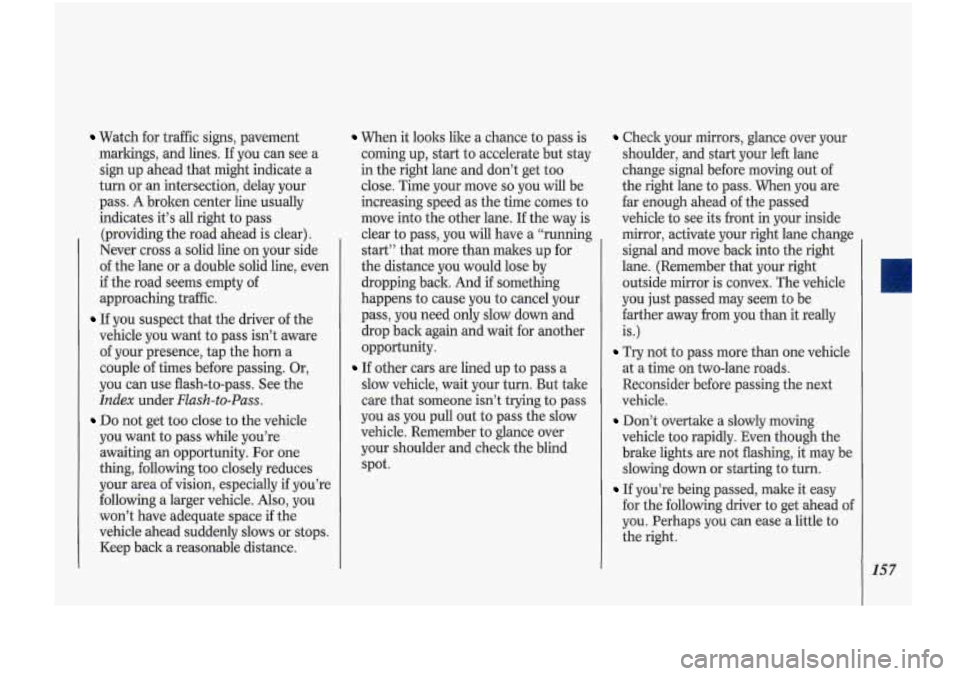
Watch for traffic signs, pavement
markings, and lines. If you can see a
sign up ahead that might indicate a
turn or an intersection, delay your
pass.
A broken center line usually
indicates it’s all right to pass
Never cross
a solid line on your side
of the lane or a double solid line, even
if the road seems empty of
approaching traffic.
If you suspect that the driver of the
vehicle you want to pass isn’t aware
of your presence, tap the horn a
couple of times before passing. Or,
you can use flash-to-pass. See the
Index under Flash-to-Pass.
Do not get too close to the vehicle
you want to pass while you’re
awaiting an opportunity. For one
thing, following too closely reduces
your area of vision, especially if you’re
following a larger vehicle.
Also, you
won’t have adequate space if the
vehicle ahead suddenly slows or stops.
Keep back a reasonable distance.
I (providing the road ahead is clear).
When it loolts like a chance to pass is
coming up, start to accelerate but stay
in the right lane and don’t get too
close. Time your move
so you will be
increasing speed as the time comes to
move into the other lane. If the way is
clear to pass, you
will have a “running
start” that more than makes up for
the distance you would lose by
dropping back. And if something
happens to cause you to cancel your
pass, you need only slow down and
drop back again and wait for another
opportunity.
slow vehicle, wait your turn. But take
care that someone isn’t trying
to pass
you as you pull out to pass the slow
vehicle. Remember to glance over
your shoulder and check the blind
spot.
If other cars are lined up to pass a
Check your mirrors, glance over your
shoulder, and start your left lane
change signal before moving out of
the right lane to pass. When you are
far enough ahead of the passed
vehicle to see its front in your inside
mirror, activate your right lane change
signal and move back into the right
lane. (Remember that your right
outside mirror is convex. The vehicle
you just passed may seem to be
farther away from you than it really
is.)
Try not to pass more than one vehicle
at a time on two-lane roads.
Reconsider before passing the next
vehicle.
vehicle too rapidly. Even though the
brake lights are not flashing,
it may be
slowing down or starting to turn.
If you’re being passed, make it easy
for the following driver to get ahead of
you. Perhaps you can ease a little to
the right.
Don’t overtake a slowly moving
157
Page 160 of 340
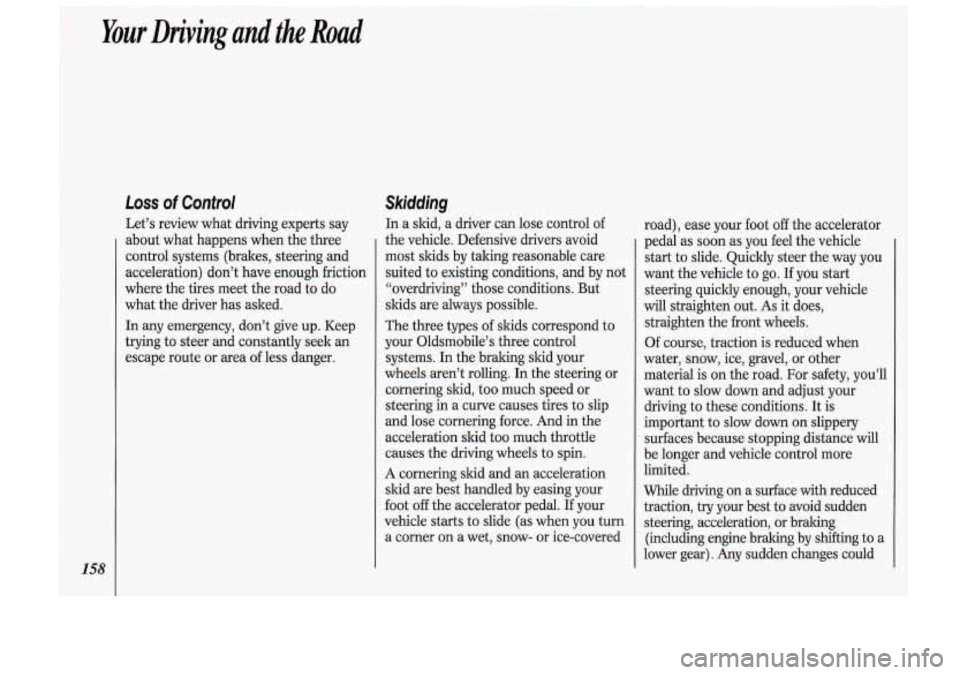
~
~~ Your Driving and the Road
158
Loss of Control
Let’s review what driving experts say
about what happens when the three
control systems (brakes, steering and
acceleration) don’t have enough friction
where the tires meet the road to do
what the driver has asked.
In any emergency, don’t give up. Keep
trying to steer and constantly seek an
escape route or area of less danger.
Skidding
In a skid, a driver can lose control of
the vehicle. Defensive drivers avoid
most skids by taking reasonable care
suited to existing conditions, and by not
“overdriving” those conditions. But
skids are always possible.
The three types of skids correspond
to
your Oldsmobile’s three control
systems. In the braking skid your
wheels aren’t rolling. In the steering or
cornering skid, too much speed or
steering in a curve causes tires to slip
and lose cornering force. And in the
acceleration skid too much throttle
causes the driving wheels to spin.
A cornering skid and an acceleration
skid are best handled by easing your
foot off the accelerator pedal.
If your
vehicle starts to slide (as when you turn
a corner on a wet, snow- or ice-covered road),
ease your foot
off the accelerator
pedal as soon as you feel the vehicle
start to slide. Quickly steer the way you
want the vehicle to go.
If you start
steering quickly enough, your vehicle
will straighten out.
As it does,
straighten the front wheels.
Of course, traction is reduced when
water, snow, ice, gravel, or other
material
is on the road. For safety, you’ll
want to slow down and adjust your
driving to these conditions. It is
important to slow down on slippery
surfaces because stopping distance will
be longer and vehicle control more
limited.
While driving on a surface with reduced
1
traction, try your best to avoid sudden
steering, acceleration, or braldng (including engine braking by shifting to a
lower gear). Any sudden changes could
Page 164 of 340
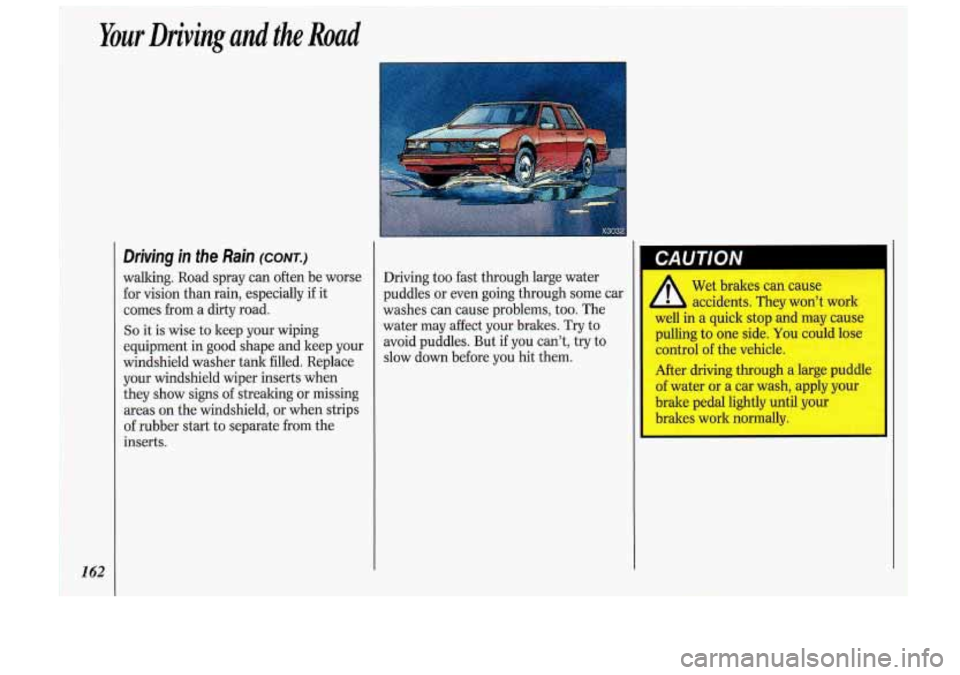
Your Driving and the Rad
162
Driving in the Rain (CONT.)
walking. Road spray can often be worse
for vision than rain, especially if it
comes from a dirty road.
So it is wise to keep your wiping
equipment in good shape and keep your
windshield washer tank filled. Replace
your windshield wiper inserts when
they show signs of streaking or missing
areas on the windshield, or when strips
of rubber start to separate from the
inserts.
I CAUTION
Driving too fast through large water
puddles
or even going through some car
washes can cause problems, too. The
water may affect your brakes. Try to
avoid puddles. But
if you can’t, try to
slow down before you hit them. Wet
brakes can cause
4 - s accidents. They won’t work
well in a quick stop and may cause
pulling to one side.
You could lose
control of the vehicle.
After driving through a large puddle
of water or a car wash, apply your
brake pedal liehtly until your
brakes
w --~’ xmallg.
Page 184 of 340
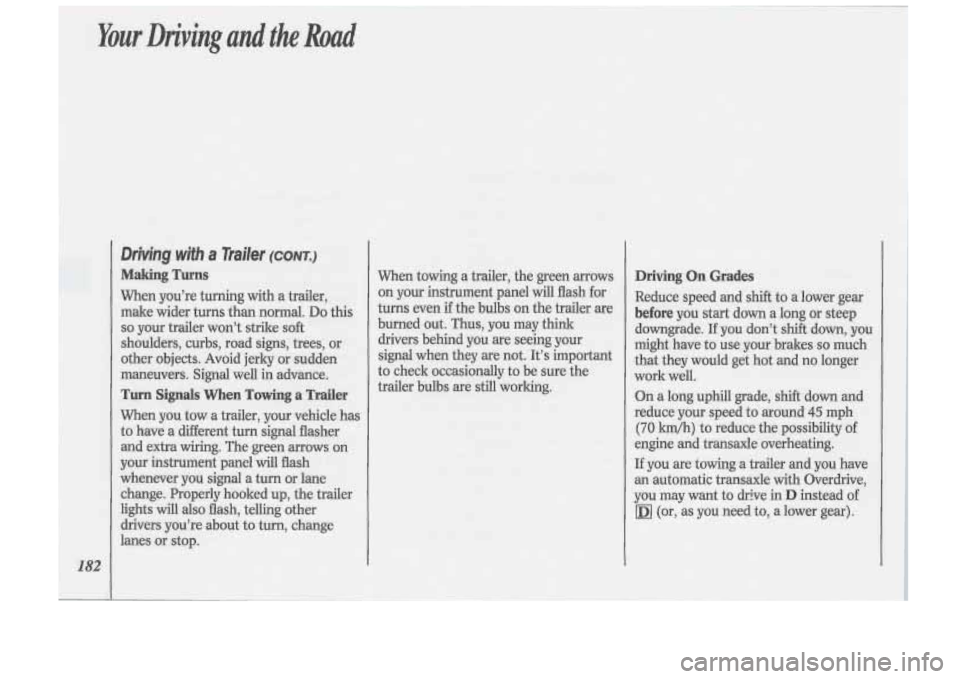
Your Driving and the Road
Driving with a Trailer (CONT.)
Making Turns
When you’re turning with a trailer,
make wider turns than normal.
Do this
so your trailer won’t strike soft
shoulders, curbs, road signs, trees, or
other objects. Avoid jerky or sudden
maneuvers. Signal well in advance.
Turn Signals When Towing a Trailer
When you tow a trailer, your vehicle has
to have
a different turn signal flasher
and extra wiring. The green arrows
on
your instrument panel will flash
whenever you signal a turn or lane
change. Properly hooked up, the trailer
lights will also flash, telling other
drivers you’re about to turn, change
lanes or stop. When towing a
trailer, the green arrows
on your instrument panel will flash for
turns even if the bulbs on the trailer are
burned out. Thus, you may think
drivers behind you are seeing your
signal when they are not. It’s important
to check occasionally to be sure the
trailer bulbs are still working.
Driving On Grades
Reduce speed and shift to a lower gear
before you start down a long or steep
downgrade.
If you don’t shift down, you
might have to use your brakes
so much
that they would get hot and
no longer
work well.
On a long uphill grade, shift down and
reduce your speed to around
45 mph
(70 lm/h) to reduce the possibility of
engine and transaxle overheating.
If you are towing a trailer and you have
an automatic transaxle with Overdrive,
you may want to drive in
D instead of
(or, as you need to, a lower gear).